Engaging Science Experiments for Preschoolers
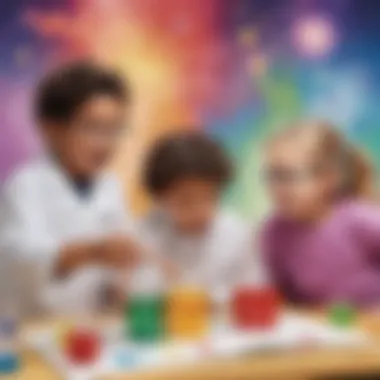
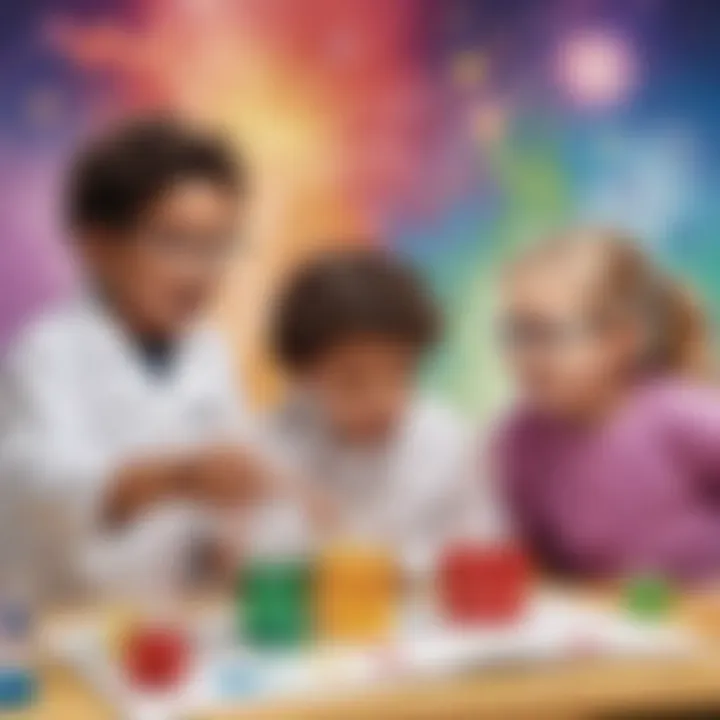
Intro
When it comes to nurturing young, curious minds, science can be an enthralling avenue for exploration. It’s not just reserved for classrooms or labs; the world of science lives in our everyday surroundings, waiting to be uncovered through hands-on activities. For preschool-aged children, science experiments serve as an exciting way to turn play into profound learning experiences. The simplicity of the materials and ideas behind these activities ignites imagination, prompting little ones to ask questions and seek answers.
The beauty of these activities lies not only in their fun factor but also in their potential to foster critical thinking skills and instill a sense of wonder about the world. Each experiment can be adapted to suit various age groups, making it a versatile resource for parents and educators alike. In this guide, we will delve into creative activities, highlight quiz options that reinforce knowledge, and summarize fact-based articles that enrich learning in an engaging way.
Let’s embark on this journey of discovery through science, where every little experiment paves the way for insight and understanding.
Creative Activities
Exploring the universe of science doesn’t have to be complicated or expensive. Rather, it can be a joyful adventure filled with creativity. Here’s how to integrate simple, fun activities into a child’s playtime.
Craft Ideas
Crafting provides an excellent platform to marry creativity with scientific concepts. Here are a few engaging ideas:
- Rainbow Jar: Using different liquids, children can create a rainbow effect in a clear jar. Each layer represents a different density, teaching them about the properties of liquids.
- Nature Collage: Collect leaves, flowers, and other natural elements and arrange them on paper to create beautiful collages. This activity helps discuss topics like biodiversity and the ecosystem.
- Volcano Eruption: Combine baking soda and vinegar in a container, add some red food coloring, and watch a bubbly eruption! This fun experiment illustrates basic chemical reactions.
Step-by-Step Guides
- Creating the Rainbow Jar
- Building the Volcano
- Materials Needed: A clear jar, honey, dish soap, water, olive oil, and food coloring (optional).
- Instructions:
- Start by pouring honey into the jar, followed by dish soap.
- Slowly add water, then olive oil. Make sure to pour it gently to create layers.
- If you want to add color, use food coloring in the water.
- Materials Needed: Baking soda, vinegar, dish soap, and food coloring.
- Instructions:
- Place baking soda in a small cup or container.
- Add a few drops of dish soap and food coloring.
- Gradually pour vinegar into the container and watch the eruption!
Educational Value
Crafts and science experiments enhance fine motor skills, encourage teamwork, and improve language development as children describe what they are doing. Furthermore, these activities provide opportunities to explore scientific principles without the heaviness of formal education, making learning a part of play.
"The greatest gift is a passionate teacher who helps young minds discover their own power to question, explore, and learn."
Engaging a child's natural curiosity through these experiments not only gives them a sense of achievement but also lays the groundwork for a love of science that will follow them into their academic journey.
Fun Quizzes
To keep the momentum of learning flowing, quizzes can be an effective way to reinforce concepts. Fun and interactive, they can engage children both at home and in educational settings.
Quiz Topics
- Nature and Environment: Questions about plants, animals, and ecosystems.
- Stellar Science: Exploring the universe and basic astronomy concepts.
- Physical Phenomena: Understanding light, sound, and basic physics concepts.
Question Types
Quizzes can include a variety of formats, such as:
- Multiple-choice questions that stimulate decision-making.
- True or false statements that promote critical evaluation.
- Fill-in-the-blank questions that develop vocabulary.
Knowledge Reinforcement
These quizzes not only test knowledge but also enhance retention. Engaging children through game-like elements nurtures enthusiasm for learning and helps solidify scientific concepts in their minds, making knowledge accessible and enjoyable.
Fact-Based Articles
Another great resource for children are fact-based articles that present information in a manner that's both informative and welcoming.
Topics
The range of topics can vary greatly, including:
- The water cycle and its importance to life.
- The anatomy of plants and how they grow.
- Simple machines and their role in everyday life.
Engaging Content
These articles break down complex ideas into bite-sized, digestible pieces. Through vibrant visuals and relatable analogies, children can easily grasp the content, enhancing their understanding and retention.
Intro to Fun Science Experiments
Science is not just a subject we learn in school; it's a way of discovering the world around us. The early years of life, especially preschool, are filled with curiosity and wonder. That's where fun science experiments come into play. They offer a hands-on approach to learning that can encourage young minds to explore, ask questions, and connect with the environment.
At this age, kids are naturally inquisitive. They’re like little sponges, ready to soak up knowledge from everything around them. Introducing them to science experiments can spark an interest that lasts a lifetime. Engaging in these activities provides not just enjoyment, but also critical thinking skills and a sense of achievement when they see results from their efforts. It’s about fostering a love for learning in a way that feels natural and exciting.
Moreover, the right kind of science experiments can pave the way for preschoolers to understand complex concepts later on. While they might not grasp the intricate details of physics or chemistry, they can certainly observe phenomena and draw connections. For instance, when kids mix ingredients for a homemade volcano, they witness a reaction. This lays the foundation for later understanding of chemical reactions in a more formal education setting.
Science at a young age is not only about learning facts; it’s about encouraging exploration and fostering a mindset of inquiry.
Understanding the Importance of Science in Early Education
Integrating science into early education is vital. It helps young learners grasp essential life skills and develop a well-rounded perspective of the world. By engaging with science, preschoolers can enhance their observational skills as they note changes during experiments. This observation is key to understanding cause and effect.
Additionally, experimenting sparks creativity and motivates problem-solving. For example, when children conduct a simple experiment to see what plants need to grow, they naturally begin hypothesizing about the effects of sunlight, water, and soil. This kind of scientific thinking encourages them to formulate questions and seek answers.
Another element of importance is collaboration. Many experiments can be done in groups, teaching kids how to work with others. They learn to share ideas, listen to feedback, and discuss observations. This group dynamic not only makes science enjoyable but instills crucial social skills that will benefit them in countless situations.
Recognizing the Developmental Benefits of Experiments
Conducting simple science experiments provides far-reaching developmental benefits for preschoolers. These experiments actively support cognitive growth. They enhance children's ability to think critically and analytically. Through straightforward procedures, like observing seeds sprouting in a cup, kids understand growth cycles and the importance of nurturing.
Furthermore, hands-on science promotes fine motor skills. Activities involving measuring, mixing, or manipulating materials help strengthen hand-eye coordination and dexterity. For instance, pouring water in a filtration experiment requires precision and concentration—it’s a fun way for kids to improve their skills unknowingly.
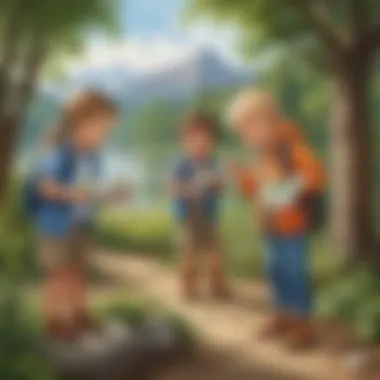
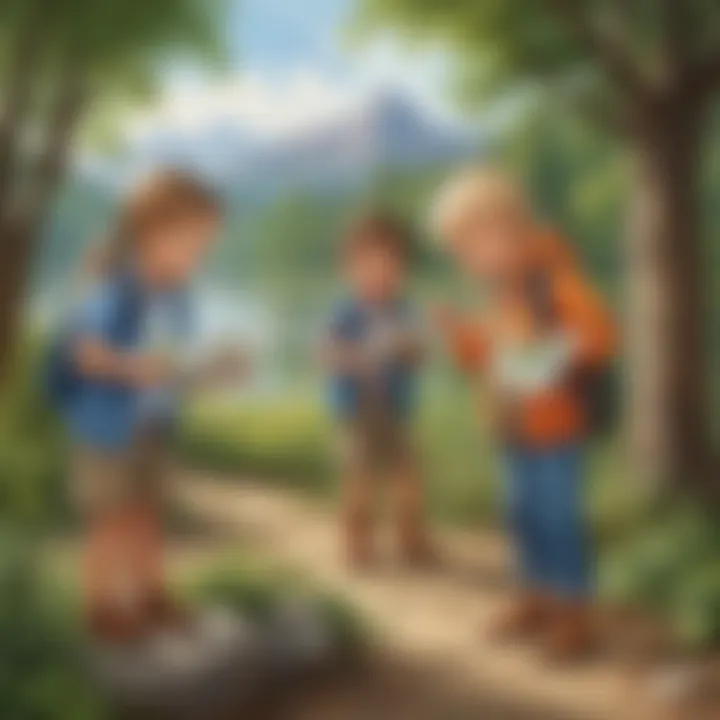
Also, tackling experiments aids language development. As kids describe their actions or results to family or peers, they practice vocabulary related to science and enhance their communication abilities. This is particularly important as they develop literacy skills, bridging the gap between spoken and written language through the lens of science.
In summary, engaging science experiments open the door to countless benefits. They provide an opportunity for preschoolers to learn, explore, and discover in a way that feels rewarding and enjoyable.
Essential Materials for Preschool Science
When we dive into the world of young learners and their budding curiosity, the essential materials for preschool science play a pivotal role in shaping their hands-on experience. These materials not only act as tools for exploration but also serve as a canvas where children can paint their scientific discoveries. It’s important that the materials are accessible, engaging, and safe, thereby laying a strong foundation for future learning.
Common Household Items for Experiments
Learning doesn’t need to come from fancy labs or pricey kits. Often, valuable experiments can be conducted with common household items. These materials foster creativity and problem-solving skills, allowing children to see the science all around them. Here are some examples:
- Baking soda and vinegar can create a mini volcanic eruption, illustrating basic chemical reactions and gas production.
- Jars and plastic cups serve well as containers for observations, whether it’s studying plant growth or observing the effects of temperature on water.
- Straws and rubber bands can be great for simple engineering experiments to understand airflow or tension.
- Paper, crayons, and scissors can be used for creating models and drawings, encouraging children to visualize concepts like the life cycle of a butterfly or the solar system.
Using these items not only engages kids with familiar objects but makes learning seamless. Just imagine cooking up a storm with science in the kitchen using flour and water to create dough, which can then be transformed into a science project by discussing textures and changes.
Safety Considerations When Conducting Experiments
Safety should be the priority when conducting any science experiment, especially with preschoolers. While this age group is naturally curious and eager to explore, they may not yet fully understand potential hazards involved in certain activities. Here are some fundamental safety considerations:
- Adult supervision is crucial. Many experiments require guidance to prevent accidents. It’s essential for parents or caregivers to be present to ensure the safety of all involved.
- Use non-toxic materials whenever possible. This ensures that in case of spills or accidental ingestion, children are safe and remain unharmed. For example, opting for natural dyes in slime rather than chemical-based colors can protect little hands and mouths.
- Establish clear rules before beginning any experiment. Explain to preschoolers what behaviors are safe and what to avoid. Simple instructions can go a long way in sum up safety practices:
- Be prepared for messes. Science experiments can get messy, and it’s important to have a designated area for experimentation and a cleanup plan ahead of time. Lay out newspapers, towels, or aprons to protect surfaces and clothing.
- No running while carrying materials.
- Keep hands away from eyes when handling ingredients.
- If something spills, let an adult handle it.
By following these precautions, children can enjoy the thrill of discovery while ensuring their safety. It helps them to focus on the joy of learning without the added worry of mishaps.
"Science is not only a discipline of reason but, also, one of romance and passion." - Wilfred Terwilliger
These considerations balance the thrill of discovery with necessary caution, making the world of science both exciting and safe for young learners.
Simple Biology Experiments for Young Learners
Biology sparks curiosity in young minds, giving them the chance to learn about living things and their environment. When preschoolers engage in simple biology experiments, they uncover the wonders of nature in ways that feel like play rather than formal learning. These experiments play a crucial role in developing their observational skills and nurturing their innate curiosity about the world around them.
Exploring Plant Growth
Materials Needed
Plant growth experiments require a few materials that are commonly found at home, making them accessible for parents and educators alike. Soil, seeds, water, and a container are the essentials. The beauty of these materials lies in their simplicity. They allow children to experience the lifecycle of plants first-hand. For instance, getting dirt under their fingernails can instill a sense of responsibility as they learn to care for their seeds. Choosing fast-growing plants like beans or sunflowers can provide instant gratification, as children witness changes daily, reinforcing patience and observation.
Step-by-Step Instructions
Following a clear and concise guide helps to ensure that the process runs smoothly. The steps to plant seeds include filling the container with soil, placing seeds into the soil, and watering them lightly. Encouraging preschoolers to follow these instructions allows them to take ownership of the experiment, which can enhance their enjoyment and understanding. An important element is repeating the instructions verbally and demonstrating them physically—the combination of auditory and visual learning can cement the process in their minds. Through this hands-on experience, children learn valuable skills that extend beyond science, such as following directions and teamwork if done in a group.
Observational Notes
Keeping track of changes in the plants encourages critical thinking. Kids can draw pictures or jot down notes reflecting their observations. The practice of recording what they see adds a layer of learning, allowing them to connect abstract ideas to observable phenomena. For example, noting that the leaves turn towards the sunlight teaches them about plant behavior, making the experiment not just about growing plants but understanding their needs. Each child may notice different details, sparking discussions that promote language development and social skills.
Investigating Insect Habitats
How to Set Up an Ant Farm
Setting up an ant farm opens doors to understanding ecosystems and social structures in nature. The main components include a clear container, some soil, and live ants. This project is engaging because children get to see ants at work, providing a lively spectacle. They can observe how ants dig tunnels and interact with one another, drawing parallels to the idea of community and teamwork. However, caution is necessary; ensuring ants are ethically sourced and not harmed in the process keeps the experiment in line with respecting living creatures.
Observation Techniques
Encouraging preschoolers to use magnifying glasses enhances their observational skills significantly. With simple techniques like noting each ant’s actions, children can learn about behaviors and roles in the colony. Inquiry-based questions, such as "What do you see them doing?" invite deeper thought. This method promotes an environment where kids feel comfortable to express their findings and ideas, thereby boosting their confidence.
Learning Outcomes
The learning outcomes from studying insect habitats are multifaceted. Not only do children recognize the role of insects in the ecosystem, but they also develop critical analytical skills. For instance, discussions about how ants collect food or care for their young lead to broader conversations about life cycles and habitats. Such experiential learning methods encourage curiosity—a fundamental building block in science education. Engaging with these complex concepts at a young age helps to solidify their understanding of biology for future education.
Basic Physics Experiments for Preschool Exploration
Exploring physics through simple experiments can open up a new world of understanding for preschoolers. Physics helps children grasp fundamental concepts like motion, force, and gravity—concepts that shape the world around them. Engaging young minds in these topics not only enhances their cognitive skills but also lays the groundwork for critical thinking. Learning about physics can lead to excitement around how things work, promoting curiosity and wonder at an early age.
Understanding Motion with Simple Machines
Building a Pulley System
Making a pulley system is an excellent way to introduce children to the idea of motion and mechanical advantage. A pulley showcases how a small effort can lift a heavier object, sparking interest in how machines can make tasks easier.
This project is straightforward and productive; children can easily get hands-on with it using items like rope and a small weight. The unique feature of a pulley is how it demonstrates the concepts of force and direction in a simple and tangible way, making it extremely beneficial for this article. However, it might be challenging for some young children to master the coordination it takes to operate the system effectively.
Results and Discussions
Results from this experiment can lead to rich discussions about the principles of physics in everyday life. Noticing how the weight moves can highlight the importance of angles and position. Learning to interpret the outcome promotes deeper understanding. It's a chance for educators or parents to guide them, fostering a narrative around their observations. Kids often feel a sense of accomplishment when they see how they can change the outcome just by modifying their approach to the system, which is a popular outcome in such experiments.
Real-World Applications
Discussing real-life examples of pulleys, like those used in construction or elevators, connects classroom learning to the outside world. This connection is critical as it not only shows the relevance of physics in everyday activities but also ignites imagination about what other types of simple machines exist. Furthermore, this experiment can serve as a springboard for discussions around engineering and problem-solving. However, it is worth noting that drawing direct connections may require a bit more explanation for young learners.
Gravity: The Falling Objects Experiment
Materials Needed
The materials for this simple gravity experiment are often already found in the home. Using familiar objects like balls, feathers, and various household items makes it easy and relatable. It's this accessibility that encourages unintentional learning while being fun. Essentially, what’s needed is a backdrop to demonstrate the fall of different objects. A unique feature of this experiment is how it highlights that gravity affects all objects, regardless of their size, creating a narrative around fairness in nature. This ease of gathering materials plays into making this experiment beneficial, with little to no costs involved.
Conducting the Experiment
To conduct this experiment, children can drop objects from a specific height and observe which land first. This hands-on approach enriches the learning experience and allows for exploration of concepts like air resistance and weight distribution. A key characteristic of this step is that children engage in active learning, which proves to be more effective than passive methods. They will discuss what they see and compare their guesses to the actual outcomes, promoting collaborative learning. However, attention must be paid to space and safety to prevent accidents during drops.
Culminations on Gravity
After conducting the experiment, discussing gravity as an invisible force that impacts everything is fundamental. Children can share their observations, leading to an understanding that gravity is constant; they can even draw conclusions on why some objects fell faster than others based on their mass and shape. Such conclusions create connections that will serve them well in the realm of science. The unique aspect of exploring conclusions from their own hands-on activities helps them to relate theory to reality, instilling a greater respect for scientific inquiry even at their tender age.
Chemistry for Little Scientists
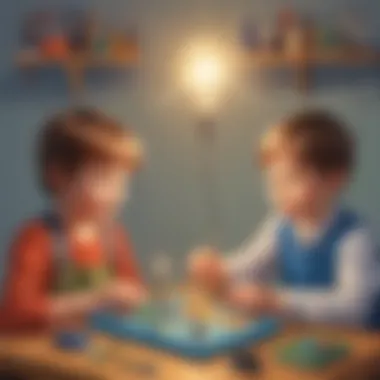
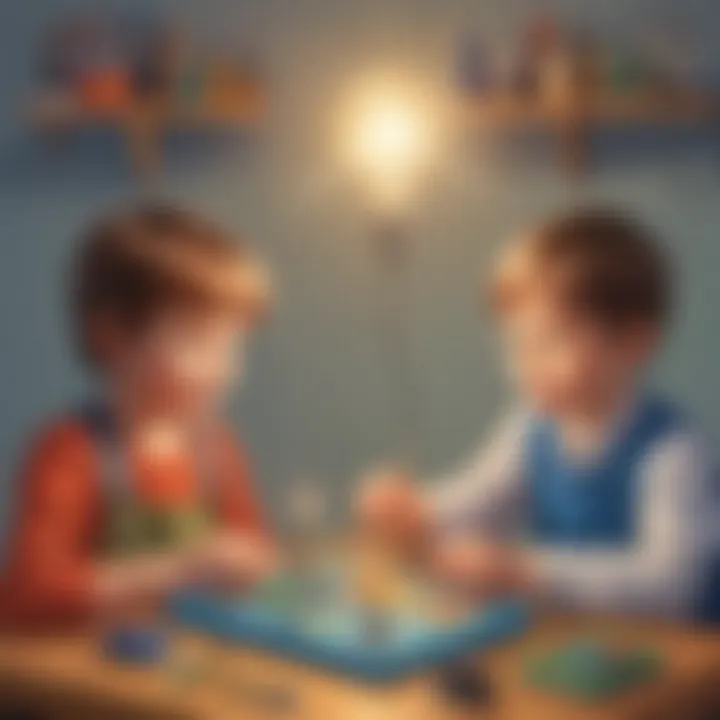
Chemistry, often considered the science of matter, plays a pivotal role in engaging the minds of preschoolers. Young children possess an innate curiosity about the world around them, and chemistry serves as a fantastic gateway to nurture that curiosity. With an array of experiments that can be easily carried out at home or in educational settings, chemistry introduces fundamental concepts that will resonate with children for years to come.
Through chemistry experiments, children not only learn about chemical reactions but also develop critical thinking skills, enhance their observational abilities, and begin to understand the scientific method. This aspect of science is particularly beneficial because it lays the groundwork for understanding not just how things work, but why they work, an important aspect of scientific literacy. Moreover, the hands-on experiences bring learning to life, allowing children to connect abstract concepts with concrete outcomes.
Creating Homemade Volcanoes
Ingredients and Materials
When making a homemade volcano, the ingredients and materials selected are crucial for an engaging experience. A classic recipe involves baking soda and vinegar, combined to produce a bubbly eruption. These items are not only readily available in most kitchens, but they also demonstrate an exciting chemical reaction.
Using common household items contributes significantly to the accessibility of this activity, enabling caregivers to partake without the need for specialized equipment. A baking soda volcano exemplifies a beneficial choice as it provides a visual and tactile experience, sparking excitement and wonder. Furthermore, the simplicity of the materials ensures safety and ease of cleanup, which is vital when engaging young children.
The Chemical Reaction Explained
Understanding the chemical reaction that occurs when baking soda meets vinegar is key to grasping the excitement of the volcano project. The reaction produces carbon dioxide gas, which creates the characteristic fizzing and bubbling. This reaction not only captivates but also introduces fundamental principles of chemical interactions, such as acid-base reactions.
By breaking down the reaction into manageable parts, children can better appreciate the cause and effect at play. Whether shared as a group activity or explored individually, the excitement generated from watching the volcano "erupt" provides a memorable learning experience. Knowing this despite the reaction's fast pace, it presents a chance for children to witness science in action.
Scientific Principles of Eruptions
The scientific principles of eruptions link wonderfully to the children’s understanding of how natural phenomena occur. Eruptions clip an adventurous edge to the experiments, inviting discussions about real-world volcanic activity. Highlighting concepts like pressure buildup from gases and the concept of eruption can be made relatable through simple explanations and comparisons.
The unique feature of discussing eruptions in terms of natural events helps bridge the gap between classroom learning and real-life scenarios, making science relatable and exciting. By contemplating how volcanoes erupt in nature, children gain insights not just into chemistry, but also geology, fostering a holistic view of science.
Making Colorful Slime
Recipe and Ingredients
Creating colorful slime is another fun chemistry experiment that captivates young learners. The basic recipe and ingredients typically include glue, water, and borax or a similar agent, all of which come together to form a sticky and stretchy substance. The simple ratios involved in slime creation allow for easy manipulation.
The appeal of slime lies in its tactile properties and the myriad of creative possibilities. Children can mix colors, add glitter, or even incorporate scents, which opens up a world of exploration and experimentation. Not only does this activity enhance fine motor skills, but it also introduces notions of viscosity and material properties, blending fun and learning seamlessly.
Discussion of Polymer Science
The discussion of polymer science becomes vital when children interact with slime. As they pull, stretch, and squeeze their creations, they engage in a hands-on exploration of polymers—long chains of molecules that give slime its unique characteristics. This concept might be complex, yet it can be simplified through play; kids can see firsthand how changing ingredients affects the slime's texture and consistency.
Presenting slime as a product of polymer science helps connect the dots between everyday activities and scientific principles. Encouraging children to ask questions about the properties—like why does it bounce or ooze—reinforces a scientific mindset.
Creative Variations on Slime
One key aspect of making slime is the opportunity for creative variations. Experimenting with different color combinations or textures encourages children to personalize their slimes. They can explore options like adding foam balls for a crunchy texture, or scents for a multi-sensory experience.
This open-ended approach plays a significant role in fostering creativity and innovation. By allowing children to make choices in their slime-making process, they become more engaged, leading to deeper learning outcomes. Discussing the outcomes of their creative explosions reinforces a sense of achievement and strengthens their desire to experiment further.
"Science isn’t about how much you know but how willing you are to inquire and experiment."
Engaging preschoolers in chemistry through projects like volcanoes and slime effectively introduces essential scientific concepts while allowing for vast creative expression, providing a virtuous cycle of learning and exploration.
Environmental Science Experiments for Preschoolers
Environmental science experiments serve as a bridge connecting young learners to the world around them. Through hands-on activities, children begin to grasp key concepts such as ecosystems, sustainability, and the critical importance of clean water. They become more aware of how their actions can impact the environment, fostering a sense of responsibility from an early age. This connection not only enhances their cognitive development but also instills a lifelong appreciation for nature and science.
Creating a Mini Ecosystem
Materials Required for a Terrarium
Setting up a terrarium is a fantastic way to introduce kids to ecosystems. The materials needed are quite simple and diverse, including a clear glass container, potting soil, small plants, and decorative stones. Each element serves a purpose: the glass allows sunlight in while keeping humidity locked inside, and the soil provides a growth medium for the plants. The key characteristic of using a glass container is that it allows children to observe the water cycle, as condensation forms on the glass surfaces.
One unique feature of terrariums is their ability to create a self-sustaining environment. As plants photosynthesize, they provide oxygen while consuming carbon dioxide, which teaches the principles of life-cycle balance. However, a disadvantage is that not all plants thrive in container life, and children may need to learn about choosing the right species.
Ways to Observe Changes
Observing changes in a terrarium captivates children's attention. A simple way to do this is by maintaining a journal where they can record observations about plant growth, moisture levels, and even the appearance of any small critters. This method increases engagement, as children can visually see the evolution of their ecosystem.
The unique feature of this observational approach is that it encourages children to ask questions and think critically. They may wonder why one plant is growing faster than another or what happens if they forget to water it. However, there can be some disadvantages, particularly if children lose interest in maintaining their journals, which may lead to less consistent observations over time.
Ecosystem Roles and Relationships
Understanding the roles different organisms play in an ecosystem is essential. In a terrarium, children can identify various roles: producers (plants), decomposers (like microorganisms), and even any predators if they introduce insects. This information promotes engagement and provides a narrative for children as they learn to recognize that every component has a purpose.
One unique feature of discussing roles and relationships is that it lays the groundwork for ecological education, helping kids understand concepts such as food chains and biodiversity. The challenge, however, lies in reinforcing this knowledge without proper guidance. Young learners may find it difficult to understand the complexity of these interactions without a structured approach.
Water Filtration Experiment
Understanding Water Purity
Water purity is a fundamental topic in both science and environmental awareness. This experiment allows children to learn about the importance of clean water and the processes involved in achieving it. Understanding the sources of water pollution, like litter or chemicals, helps children connect actions to their consequences.
The key characteristic of this topic is its relevance; clean drinking water is essential not just for humans but for all living beings. The unique feature is that it can empower children with knowledge to advocate for clean water practices. On the flip side, it could expose them to concerning realities about pollution, which might be daunting without existing coping strategies.
Steps to Create a Filter
Creating a simple water filter can be both educational and engaging. The materials required include sand, gravel, charcoal, and a container to hold them. Children can layer these materials, watch how they influence the clarity of the water, and understand the mechanics behind filtration. This step-by-step process is beneficial as it promotes hands-on learning and critical thinking.
One unique advantage is that kids can experiment with different materials to see what works best, teaching problem-solving skills. The downside might be that children can become frustrated if their filter fails, impacting their confidence unless properly guided through failures as learning opportunities.
Results Discussion
Discussion of results is crucial for cementing the learning experience. Children should be invited to share their findings and thoughts during group discussions after the experiment. This allows for a collaborative learning environment where they can learn from one another's experiences and observations.
The key aspect of this discussion is fostering communication skills and teamwork. Children learn to articulate their thoughts, listen to others, and think critically about the results. A potential drawback is if discussions remain superficial or guided too strictly, hindering creative thinking and exploration of ideas. Encouraging open-ended questions may help mitigate this, allowing kids to express themselves freely.
Engaging with Astronomy through Simple Experiments
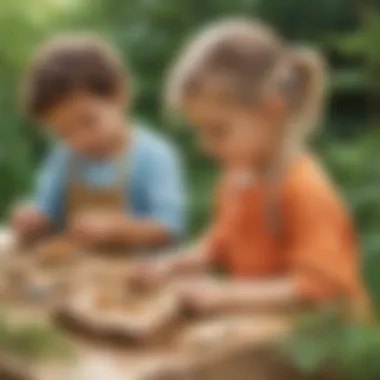
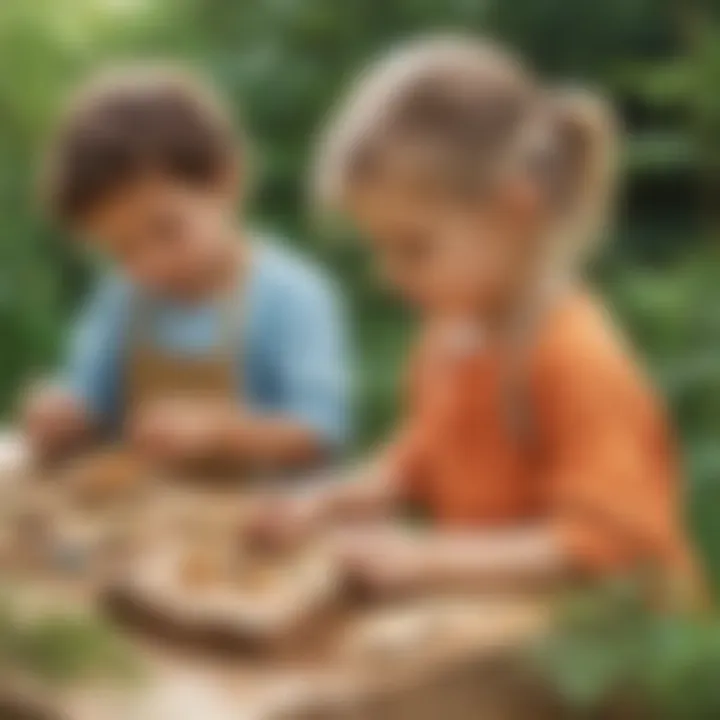
Astronomy is one of the oldest sciences and delves into the wonders of the universe, inviting curiosity from a young age. For preschoolers, engaging with astronomy offers more than just stargazing; it opens avenues for creativity, problem-solving, and a foundational understanding of the world around them. Through simple experiments, children not only learn about stars, planets, and the concepts of space but also develop a lasting sense of wonder about the natural world. The sky at night is a vast canvas—understanding that this canvas is filled with celestial bodies can inspire young minds to ponder questions bigger than themselves.
Creating Constellations at Home
Materials and Ideas
To embark on this stargazing journey at home, the materials needed are quite simple. You’ll primarily need some black construction paper, a white crayon or chalk, and optionally, a star map for guidance. Paper and crayons are easily accessible and inexpensive, which makes them a popular choice among parents and educators. What stands out here is the interplay between creativity and education—children can express themselves by designing their own constellations while learning.
The unique feature of this activity is that it sparks imagination. While kids draw their constellations, they are simultaneously enhancing fine motor skills. However, one potential drawback is the reliance on visual imagination; some children may struggle to assign patterns to dots. Still, with a little guidance, they usually catch on quickly.
Understanding Star Patterns
Recognizing star patterns is fundamental to astronomy. Teaching preschoolers to identify patterns not only helps them connect the dots literally but also metaphorically. By concentrating on stringing stars together, children learn about organization and classification, key elements in early science education. This process feels intuitive, turning learning into a playful experience.
The simplicity of understanding star patterns makes it a prevalent choice for parents looking to introduce science to their children. One remarkable aspect of this is how it encourages storytelling—each constellation can lead to tales of myths and legends, fostering a cultural education alongside a scientific one. On the downside, children may have difficulty deciphering intricate star maps, necessitating some simplification.
Linking to Real Astronomy
Linking childhood activities to real astronomy offers an authentic experience that connects dots beyond mere crafts. This could mean discussing the stories behind constellations or even watching documentaries suitable for kids that detail our universe's vastness.
This connection to actual astronomy enriches children's understanding, showing them the real-life implications of what they are learning. A downside could be the challenge of ensuring that content remains interesting yet age-appropriate, but there are plenty of resources available that do just that. This blend of imagination and reality not only instills a love for science but also lays down the groundwork for future explorations.
Building a Simple Sundial
Materials Needed
Creating a sundial involves a few simple materials: a stick, some stones, and a flat piece of ground. The key characteristic of this activity is that it is hands-on, allowing kids to directly interact with the concept of time. The versatility of sundials—as simple, easily made objects—makes them a staple in educational experiments. Plus, kids learn about how ancient civilizations told time without modern tools.
One unique feature of this project is its multi-dimensional learning aspect; while they build the sundial, children explore concepts of time and shadow simultaneously. Though most materials are easily found, weather conditions can affect visibility, which might limit planning.
Measuring Time with Shadows
The concept of using shadows for measuring time may seem abstract for preschoolers, yet it makes a memorable impact. When young learners see how the sun's position changes throughout the day, they gain insights into time, seasons, and even basic astronomy.
This method is beneficial because measuring time through shadows creates a tangible connection to nature. Kids get to observe real changes right in their backyard! However, one disadvantage could be cloudy weather interfering with their observations, requiring some flexibility in scheduling.
Connecting to the Concept of Time
Linking this exercise back to the broader concept of time is invaluable for children. They learn not just when things happen, but why rocks cast shadows and the earth rotates. This comprehension can serve as an enduring reference point when discussing calendars, seasons, and even aging.
Notably, this method reinforces critical thinking—a return to the core of science education. While the challenge is ensuring clarity about abstract concepts for young minds, the more hands-on experiences they have, the better they understand.
In summary, astronomy can ignite a passion for science in preschoolers, all through simple yet effective experiments. These activities serve as gateways to deepen their comprehension of the world, enriching both their intellect and imagination.
By engaging with astronomy through hands-on activities, parents and educators can guide children into a world ripe for exploration—leaving them with questions that spark further discovery.
Tips for Successful Science Experience at Home
Creating a vibrant science experience at home is like planting seeds in a child's mind that can bloom into a garden of curiosity and understanding. The essence of fostering scientific exploration in young children lies in making the process enjoyable and meaningful. This section focuses on cultivating a nurturing environment for preschoolers as they dabble in hands-on experiments.
The key factors to ensure success are preparation, engagement, and reflection. Being prepared means having the right materials ready and setting up a safe, designated space for experiments. When children see where they can experiment, it naturally sparks their interest. Think of this space as their own little lab where their imaginations can run wild!
Guiding Questions for Discussion
Once an experiment is complete, discussions become a valuable tool for reinforcing learning. Asking careful, open-ended questions encourages children to think critically about what they just did. Here are a few questions that can guide the conversation:
- What do you think will happen if we change this part of the experiment?
- Can you explain in your own words what we did?
- How did you feel when you saw the results?
These questions serve not just as a recap of activities but help in developing logical reasoning and communicating thoughts. When children share their ideas, they learn to express themselves better, while also internalizing what they've learned, ensuring long-lasting impacts.
Fostering Critical Thinking Skills
Critical thinking is an essential skill that benefits children beyond just science. Through experiments, preschoolers engage in problem-solving and analytical thinking. Here’s how you can nurture these skills:
- Encourage Exploration: Let kids explore variations of the experiment. For example, if they are making the volcano erupt, ask them what they think would happen if they use more or less baking soda. Experimentation leads to deeper understanding.
- Promote Observation: Teach kids to observe carefully. Noting tiny changes—even things that may not seem significant—can lead to exciting discussions and insights.
- Normalize Mistakes: Mistakes should not be viewed negatively. Instead, explain that errors are part of learning. By highlighting that refining an idea often comes from trial and error, children will develop resilience and creativity.
"The best scientists often begin with a question; guide your child to ask why and how every time they observe something new."
- Connect Ideas: Help them bridge what they learn from experiments to the real world. For instance, if they observe how plants grow, discuss how that knowledge connects to food, nature, and ecosystems.
By cultivating these habits early, children will not only enjoy the wonders of science but also build a strong foundation that can influence their learning journey in diverse subjects throughout their lives. The lessons learnt are not just academic; they become life skills that will stay with them long after leaving the age of preschool.
End and Further Resources
Reflecting on the engaging journey of science experiments for preschoolers, we unlock a treasure trove of benefits not just for curious minds, but also for their educators and caregivers. The role of early science education can hardly be overstated. It instills a foundational understanding of the world around, sparking interest and wonder. By keeping learning hands-on and interactive, children tend to develop critical thinking skills that serve them well in later stages of education.
Moreover, providing additional resources is crucial in enhancing the practicality of these experiments. Familiarizing children with literature, online platforms, and multimedia content fosters not only learning but also a genuine curiosity that transcends the classroom walls. These resources complement the hands-on activities, making science a lively part of their daily lives.
"The more we give preschoolers the chance to explore, the more they discover their potential."
Summarizing the Benefits of Early Science Education
Early exposure to science can cultivate a range of skills and values in preschoolers. It shapes their ability to engage thoughtfully with their environment, nurturing skills like observation, hypothesizing, and problem-solving from a tender age. As they interact with materials, their sensory experiences are heightened, paving the way for a deeper understanding of basic scientific principles.
Additionally, science education promotes collaboration, as children often work in pairs or groups. Sharing ideas and findings creates a sense of community, which is invaluable at such a formative stage of development. It lays the groundwork for interpersonal skills that will be beneficial throughout their lives.
Additional Resources and Readings
Books for Young Scientists
Books aimed at young scientists play a pivotal role in expanding children's horizons. They provide vivid illustrations and relatable narratives that explain scientific concepts in simple terms. Titles like "The Magic School Bus" series bring science to life, making complex ideas accessible. One of the hallmark features of such books is their ability to spark imaginations. Young learners can visualize what they read and are often inspired to replicate experiments at home, completing the loop of engagement. However, the challenge lies in choosing books that align with children's comprehension levels—while some may inspire, others might overwhelm.
Websites and Online Portals
Digital resources have become invaluable in today's tech-savvy world. Websites tailored for young learners provide interactive content that complements what children experience in hands-on experiments. Sites like National Geographic Kids offer fun facts and engaging visuals that can deepen understanding and interest in scientific exploration. One of the standout attributes of such portals is their availability; children can access a wealth of information at their fingertips. Yet, the downside can be the need for adult supervision, as some content might not be entirely suitable for preschoolers, necessitating parental guidance to navigate safely.
Videos and Documentaries
Visual content like videos or documentaries tailored for little ones can bridge the gap between theory and hands-on practice. Shows like “Cosmos: A Spacetime Odyssey” have kid-friendly versions that unravel complex topics into chunks digestible by young minds. These visual mediums capture attention and explain scientific phenomena through captivating storytelling and visuals. However, while they can be motivational, there is a risk of relying too heavily on screens rather than encouraging active participation in experiments.
In sum, expanding the world of preschool science through diverse resources only enhances learning. Combining hands-on experiences with a rich array of books, digital content, and multimedia tools paints a fuller picture of science as a dynamic and engaging field.







